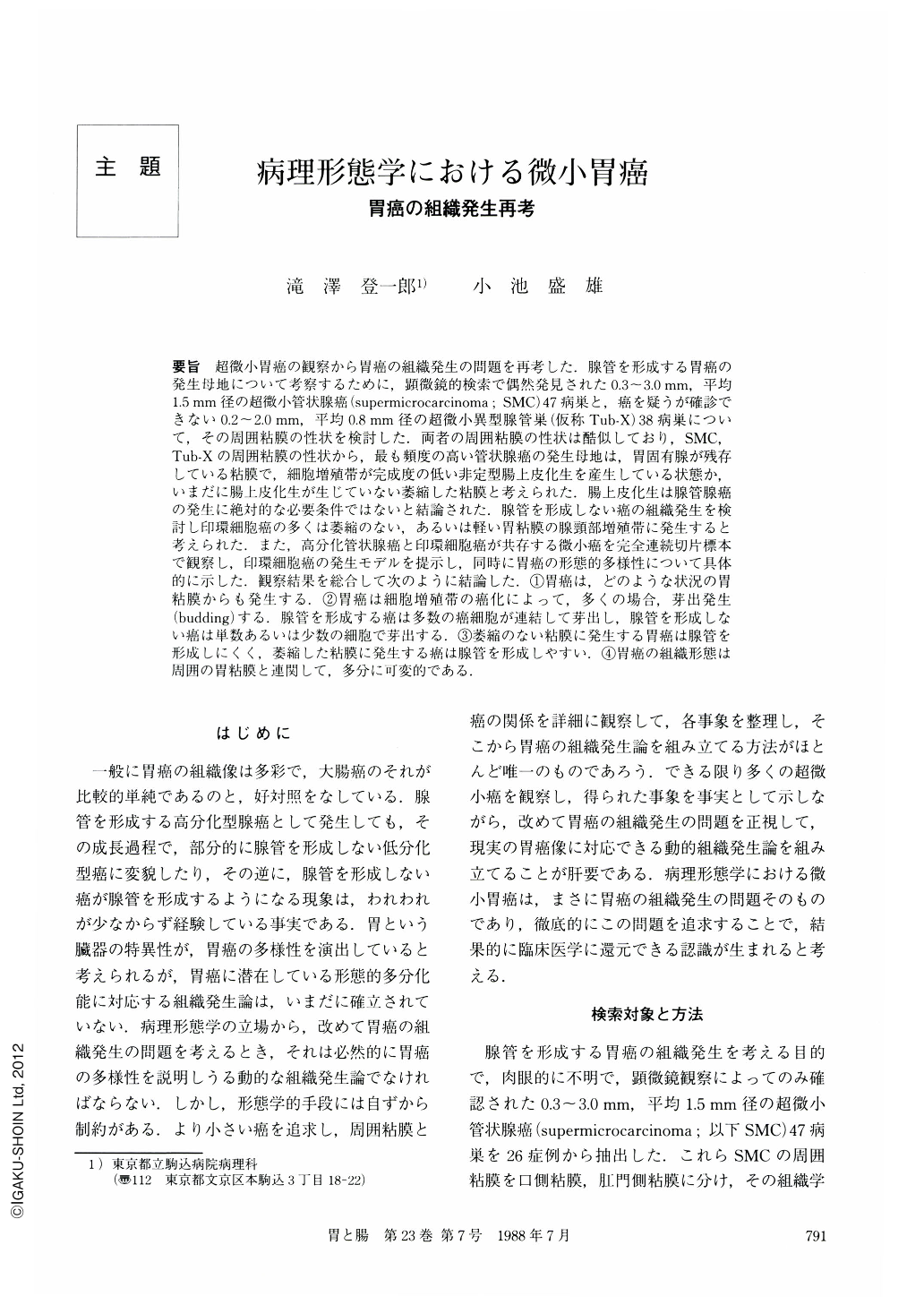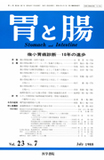Japanese
English
- 有料閲覧
- Abstract 文献概要
- 1ページ目 Look Inside
- サイト内被引用 Cited by
要旨 超微小胃癌の観察から胃癌の組織発生の問題を再考した.腺管を形成する胃癌の発生母地について考察するために,顕微鏡的検索で偶然発見された0.3~3.0mm,平均1.5mm径の超微小管状腺癌(supermicrocarcinoma;SMC)47病巣と,癌を疑うが確診できない0.2~2.0mm,平均0.8mm径の超微小異型腺管巣(仮称Tub-X)38病巣について,その周囲粘膜の性状を検討した.両者の周囲粘膜の性状は酷似しており,SMC,Tub-Xの周囲粘膜の性状から,最も頻度の高い管状腺癌の発生母地は,胃固有腺が残存している粘膜で,細胞増殖帯が完成度の低い非定型腸上皮化生を産生している状態か,いまだに腸上皮化生が生じていない萎縮した粘膜と考えられた.腸上皮化生は腺管腺癌の発生に絶対的な必要条件ではないと結論された.腺管を形成しない癌の組織発生を検討し印環細胞癌の多くは萎縮のない,あるいは軽い胃粘膜の腺頸部増殖帯に発生すると考えられた.また,高分化管状腺癌と印環細胞癌が共存する微小癌を完全連続切片標本で観察し,印環細胞癌の発生モデルを提示し,同時に胃癌の形態的多様性について具体的に示した.観察結果を総合して次のように結論した.①胃癌は,どのような状況の胃粘膜からも発生する.②胃癌は細胞増殖帯の癌化によって,多くの場合,芽出発生(budding)する.腺管を形成する癌は多数の癌細胞が連結して芽出し,腺管を形成しない癌は単数あるいは少数の細胞で芽出する.③萎縮のない粘膜に発生する胃癌は腺管を形成しにくく,萎縮した粘膜に発生する癌は腺管を形成しやすい.④胃癌の組織形態は周囲の胃粘膜と連関して,多分に可変的である.
Compared with those of colonic cancer, histological features of gastric cancer are extremely complex. Actually, some gastric carcinomas show a histological variety ranging from well differentiated to poorly differentiated adenocarcinoma. There actually exists a gastric carcinoma in which signet-ring cell carcinoma coexists with well differentiated tubular adenocarcinoma. It seems that almost all gastric carcinomas have a certain potentiality to transform their histological features according to the condition of the surrounding mucosa.
Many previous investigations concerning the histogenesis of gastric carcinoma were insufficient for explaining such histological variability in gastric carcinoma. The aim of the present study is to establish a new practical theory on the subject of histogenesis of gastric carcinoma.
In order to analyse the histogenesis of tubular gastric carcinoma, 47 supermicrocarcinomas (SMC; 0.3-3.0 mm, average 1.5 mm in diameter), which were able to be detected only by microscopical observation, and 38 microscopical atypical tubular lesions (Tub-X; 0.2-2.0 mm, average 0.8 mm in diameter), which suggested but did not give conclusive evidence of carcinoma, were histologically examined with reference to the surrounding mucosa. We divided the surrounding mucosa; oral and anal mucosa adjacent to SMC and Tub-X, into five groups.
A Group; gastric mucosa with typical intestinal metaplasia, only; typical pure.
B Group; gastric mucosa with typical intestinal metaplasia and proper gastric glands; typical composite.
C Group; gastric mucosa with non-typical intestinal metaplasia, only; non-typical pure.
D Group; gastric mucosa with non-typical intestinal metaplasia and proper gastric glands; non-typical composite.
E Group; atrophic gastric mucosa without intestinal metaplasia.
Typical intestinal metaplasia shows well developed brush border and Paneth cell. Intestinal metaplasia without Paneth cell and well developed brush border is classified as non-typical.
The quality of gastric mucosa adjacent to SMC was determined as follows; D Group (44.7%), E Group (30.8%), A Group (12.8%), B Group (11.7%), C Group (0%), and then concerning Tub-X, D Group (40.8%), E Group (30.3%), A Group (17.1%), B Group (7.9%), C Group (3.9%). There are significant differences between these groups. The percentage distribution among groups in SMC is quite similar to that in Tub-X. Hence, it seems that Tub-X should be evaluated as an important lesion when considering the problem of the histogenesis of tubular gastric carcinoma. D Group, gastric mucosa with non-typical intestinal metaplasia and with the proper gastric glands remaining, is most frequently observed as the neighboring mucosa of both SMC and Tub-X. On the contrary, C Group (only non-typical intestinal metaplasia) is found least in both SMC and Tub-X. Hence, the existence of proper gastric glands should be estimated as an essential factor for the genesis of tubular gastric carcinoma. These results indicate that most tubular gastric carcinomas arise from atrophic gastric mucosa with the proper gastric glands remaining. For the genesis of tubular carcinoma, intestinal metaplasia per se may not be a prerequisite.
Some authors have reported that in situ proliferation of carcinoma cells replacing non-cancerous epithelium was an initial feature of tubular carcinoma. We carefully examined 11 SMC from 0.3 mm to 0.7 mm in diameter, and no in situ growth or proliferation of carcinoma was detected. According to our observations, it seems that most tubular carcinomas bud from a cancerized generative zone.
For the histogenesis of non-tubular gastric carcinoma, nine minute lesions of signet-ring cell carcinoma (0.4-1.5 mm in diameter) were examined. Two of these lesions were analysed by serial sections. All lesions were observed in non-atrophic and/or slightly atrophic gastric mucosa, especially at the level of the neck portion corresponding to the generative cell zone. Although we examined two minute lesions with serial sections, we could not clarify the morphological evidence sufficiently to discover the genesis of signet-ring cell carcinoma.
So far as we observed, it may be presumed that most signet-ring cell carcinomas bud from the cancerized generative zone of non-atrophic and/or slightly atrophic gastric mucosa as single carcinoma cells, or as a low number of carcinoma cells.
With use of complete serial sections, we examined a minute cancer in which signet-ring cell carcinoma coexisted with well differentiated tubular adenocarcinoma. Morphological evidence concerning the separation of signet-ring carcinoma cell from tubular adenocarcinoma was verified. At first, an immature signet-ring carcinoma cell developed in the tubular carcinoma. As this carcinoma cell became mature and mucous rich, it gradually became estranged from the tubular carcinoma and, at last, following complete destruction of the basement membrane, the signet-ring carcinoma cell separated from the tubular carcinoma and then floated in the stroma. These morphological findings may be a model for the genesis of signet-ring cell carcinoma. The signet-ring carcinoma cells seem to separate continuously from the cancerized generative cell zone, somewhat like bullets from a machine gun.
Conclusion:
Among the previous investigations concerning the histogenesis of gastric carcinoma, the theory proposed by Nakamura is the most convincing one. Nakamura's theory is summarized as follows; undifferentiated carcinoma develops from the proper mucosa of the stomach, while differentiated carcinoma develops from the gastric mucosa that has undergone intestinal metaplasia. The theory is very clear, but too clear for explaining the complexity of real gastric carcinoma. Actually, we have many cases of exceptions to Nakamura's theory. A little modification may be necessary to make the theory truer to reality. Our observations and considerations are summarized as follows;
1) Gastric carcinoma may arise from any condition of gastric mucosa.
2) Tubular gastric carcinoma most frequently arises from atrophic gastric mucosa with or without non-typical intestinal metaplasia, which is not a prerequisite for the genesis of tubular carcinoma.
3) Non-tubular gastric carcinoma (signet-ring cell carcinoma) frequently arises even in non-atrophic and/or slightly atrophic gastric mucosa.
4) “Budding” from a cancerized generative cell zone is a fundamental pattern in the genesis of gastric carci-noma. The budding of a combination of many cancer cells makes tubular carcinoma, and the budding of a single or a few cells makes non-tubular carcinoma.
Consequently, the histogenesis of gastric carcinoma may be very simple. It should be presumed that gastric carcinoma arising from non-atrophic gastric mucosa forms a tubular structure only with difficulty, while carcinoma arising from atrophic mucosa easily forms a tubular structure.

Copyright © 1988, Igaku-Shoin Ltd. All rights reserved.


